Assessing the Demand Side Management Potential and the Energy Flexibility of Heat Pumps in Buildings
Abstract
:1. Introduction
2. State of the Art Review of DSM Technologies for Air Conditioning and Heat Pumps
2.1. Energy Efficiency
- The use of natural refrigerants is gaining more and more interest. Harby [10] focuses, for example, on the problems (environmental impacts and energy use) associated with the use of halogenated refrigerants and the possibility to replace them with hydrocarbons (HC). The author provides a guide to understand the current status, replacement strategy of conventional refrigerants, and possible drawbacks in using HC. Bolaji and Huan [11] review existing natural refrigerants (HC, ammonia, CO2, water) and their areas of application in refrigeration and air-conditioning systems. They show the potential of natural refrigerants to replace halogenated refrigerants. Nawaz et al. [12] propose propane and isobutene as natural refrigerants for heat pump water heaters, while Zajacs et al. [13] analyze the possibility of using ammonia in a heat pump for space heating and domestic hot water production.
- Among the other technologies, variable capacity compressors are considered as an effective way to achieve energy efficiency for air-conditioning chillers and heat pumps. Krishnamoorthy et al. [14] present the cooling operation of a variable-capacity/variable-fan-speed heat pump and they show its potential to reduce residential energy use, highlighting also the importance of location and insulation level of the duct system. Park et al. [15] evaluate the performance of a variable refrigerant flow (VRF) air conditioning (AC), that is, an air-conditioning system able to control the amount of refrigerant flowing to the multiple evaporators (indoor units). They assess energy use and comfort of occupants for a Korean building and obtained results confirming the advantages of a VRF system. Aynur et al. [16] compare a VRF AC system with a variable air volume (VAV) AC and assess a potential energy saving between 27% and 58% depending on the system configuration, and indoor and outdoor conditions. Özahi et al. [17] show for a real case that variable refrigerant flow systems can produce a 44% cost saving compared to traditional HVAC systems. Among the ways of improving the performance of a vapor compression refrigeration cycle, using an ejector as an expansion device is one of the possibilities [18]. The ejector is a machine without movable organs that can be used as a compressor and as a pump to achieve a pressure rise of a given fluid through supply of another fluid with the same or different nature. Wang et al. [19] describe a hybrid ejector air-conditioning system and its optimization. The proposed system has the compressor installed between the outlet of evaporator and ejector secondary flow inlet. The optimization of such a system leads to a 7% energy use reduction. Boccardi et al. [20], instead, evaluate the performance improvement due to an ejector in a HVAC system working with CO2 as refrigerant. The optimal configuration of the system is determined.
- Not-in-kind technologies category includes the following technologies for domestic applications: thermoacoustic refrigeration, thermoelectric refrigeration, thermotunneling, magnetic refrigeration, Stirling cycle refrigeration, pulse tube refrigeration, Malone cycle refrigeration, absorption refrigeration, adsorption refrigeration, and compressor driven metal hydride heat pumps [21]. Among all the others, magnetic refrigeration shows fast developments in new materials and system architecture, and it is considered very promising as an alternative to some conventional cooling, refrigeration, and air-conditioning technologies [22].
- Energy recovery is of paramount importance to increase the efficiency of an HVAC and it can be performed, for example, by means of an enthalpy wheel or heat exchangers, whose performance can be enhanced by the inclusion of phase change material (PCM) [23]. Du et al. [24], instead, analyze different control strategies for achieving energy savings with a HVAC system in an airport. They make a comparison on the basis of an exergy based method. Ascione et al. [25] present a methodology for the optimization of a building-HVAC system by employing a model predictive control (MPC) strategy for heating and cooling. The authors show a primary energy saving around 35.4 kWh/m2 for a residential building in Southern Italy. Indeed, several studies have shown that by adding a supervisory MPC controller to HVAC systems could result in energy use and operating cost reductions from 7% to more than 50% [26,27,28].
2.2. Energy Storage
2.3. Demand Response
- Ancillary services consist of frequency and voltage control, congestion management, and provision of spinning and non-spinning reserve [37]. In voltage control applications, heat pump load is modified to maintain the distribution network voltage within the allowed limits: heat pump (HP) active power demand is decreased in times of local under-voltage and increased in times of over-voltage. The latter case can happen, for example, in presence of photovoltaic (PV) panels, feeding electricity in the grid. In a similar manner, frequency control can be realized to ensure that the grid frequency stays within a specific range of the nominal frequency. An existing example of application is the virtual energy storage network, named “tiko”, which connects more than 10,000 electric heating devices (i.e., heat pumps and water heaters) throughout Switzerland [38]. As far as congestion management in the distribution grid is concerned, optimized scheduling and power rating of heat pumps are paramount in order to avoid limitations in the transformer and line capacity [37,39]. Eventually heat pumps can serve as spinning and non-spinning reserves used by the transmission system operator (TSO) [37,40], that is, as reserve capacity that can be regulated downward or upward to match demand and supply. Different strategies can be implemented with these reserves, such as peak clipping or valley filling. In References [41,42,43], incentive based DR programs are considered to provide ancillary services to the power system by means of active demand and their influence on the real power markets is assessed.
- Another important role played by heat pumps and the flexibility they provide is related to the possibility to integrate renewable energy sources both at building level and at power system level. The main RES considered are wind and PV. Bruninx [40] shows the impact on wind utilization factor (WUF) produced by heat pumps adhering to a DR program: on average, the WUF increases from about 75% in the reference case to 84% when heat pumps are used as operational reserves. This increase of WUF is the result of shifting demand to periods of excess wind power generation and of increasing the indoor temperature in order to allow the DR adherent heating systems to provide upward reserves. Baetens et al. [44] demonstrate the positive role of heat pumps to reduce curtailment of electricity from PV panels. Arteconi et al. [45] show how heat pumps coupled with thermal storage can increase the self-consumption of PV electricity production in an industrial building. In this study, the tank operative conditions are analyzed in order to find the best configuration: up to 80% of PV electricity can be used to cover the thermal demand coming from the building.
- Regarding energy bill reduction, electricity price signals are used to influence the final user’s consumption pattern. Mainly, there are two types of tariff structures: Time of Use (TOU) tariffs, varying on the period of the day, and Real Time Pricing (RTP), changing with the electricity market price [46]. The heat pump demand can be shifted driven by the price with the intent of reducing electricity costs, improving the system performance, increasing RES integration, or improving power system benefits (i.e., reducing total operational costs). It is evident how the final users and power system interests are strictly related. However, it has been demonstrated that the benefit that a final user can achieve in taking part in a DR program depends also on the number of participants: the operational cost reduction per participant drops when increasing the penetration of DR programs because less flexibility is requested of each user. In more detail, the total cost savings have been assessed at most between about 400 € to 200 € per participant per year for a 5% and 100% DR penetration rate, respectively [47]. In Reference [48], price-controlled energy management of smart homes (SHs) is investigated and it is demonstrated that the benefit for both the generation scheduling problem and for the final users, is a decrease in operational costs. Even in Reference [49], demand response programs are modeled in the unit commitment (UC) problem in order to evaluate achievable operational costs savings.
3. Methods
3.1. Flexibility Evaluation
- number of hours the energy use can be delayed or anticipated [50];
- power increase or decrease and time duration of its variation within functional and comfort limits [51];
- energy cost, based on cost functions, which represent how much shifting the energy use costs [52];
- ratio between the maximum change in power to the additional energy use in a certain period (efficiency curves) [53];
- power demand versus priority to be supplied in order to satisfy the operational constraints (priority curves) [54];
- maximum heat that can be stored in the structural storage capacity of a building without violating the thermal comfort [55];
- hourly (h) load shed potential of a device with respect to its rated power consumption (Pbase) during a DR event (DRp), as shown in Equation (1) [36]:
3.2. Case Studies
- a HP energy efficient design (variable capacity HP),
- a thermally stratified water tank,
- a DR program based on dynamic pricing
3.2.1. Case A: Energy Efficiency
3.2.2. Case B: Energy Storage System
3.2.3. Case C: Demand Response
4. Results and Discussion
4.1. Case A
4.2. Case B
4.3. Case C
4.4. Discussion
- energy efficient devices, represented by a more efficient variable capacity heat pump,
- thermal storage, where different tank volumes are coupled with HP and radiators,
- demand response, implemented by means of a variable internal temperature set-point which reflects a variable electricity price.
- Energy efficient DSM technologies allow energy conservation (reduction of the overall load) and, as a consequence, peak shaving (reduction of the maximum load). Indeed, the variable capacity HP is ON for longer periods but with a lower load.
- Energy storage systems achieve load shifting, and the time shifting depends on the amount of energy that can be stored. Without any other external constraints, the storage volume affects the operation of the system and the time to which the load is shifted.
- Eventually DR programs, based on real time pricing, use the price signal to induce the user to shift their load to hours with a lower electricity price. With DR programs, load shifting to off-peak hours (valley filling, i.e., building off-peak loads) and consequently peak shaving of the overall power system can be operated.
5. Conclusions
- Energy efficiency actions can produce mainly peak shaving and energy conservation. When such action is represented by a variable capacity heat pump, the load is always present but with lower values (50% or even less). In case of distribution systems with a high thermal inertia, such as underfloor heating, the energy use can be postponed for several hours (8 h in the analyzed case).
- Energy storage systems allow load shifting. The amount of energy that can be shifted depends on the storage size and, unless in presence of external constraints, the time to which the load is moved cannot be actively controlled. The time shifting in cases of low thermal inertia distribution systems, that is, radiators, is limited but the relative power that can be postponed is high (100% of the nominal value).
- DR operates an active load shifting to off-peak hours (valley filling) and peak shaving. In this case, energy is used in advance in comparison with the reference case. The time shifting is long in the presence of underfloor heating systems (for a 100 m2 apartment it can be anticipated at 4 h). This kind of strategy tends to increase the overall energy consumption but allows a better operation of the power system avoiding high peak demand.
Author Contributions
Funding
Acknowledgments
Conflicts of Interest
References and Note
- EIA (Energy Information Administration). How Much Energy is Consumed in Residential and Commercial Buildings in the United States? Available online: http://www.eia.gov/tools/faqs/faq.cfm?id=86&t=1 (accessed on 13 July 2018).
- EU (European Union). Energy Efficiency-Buildings. Available online: https://ec.europa.eu/energy/en/topics/energy-efficiency/buildings (accessed on 13 July 2018).
- Coulomb, D.; Dupont, J.L.; Pichard, A. The Role of Refrigeration Industry in the Global Economy; Report No. 29th Informatory Note on Refrigeration Technology; International Institute of Refrigeration: Paris, France, November, 2015. [Google Scholar]
- Thomas, N.; Pascal, W. European Heat Pump Market and Statistics Report 2015; Technical Report for The European Heat Pump Association AISBL (EHPA): Brussels, Belgium, 2015. [Google Scholar]
- Callaway, D.S.; Hiskens, I.A. Achieving controllability of electric loads. Proc. IEEE 2011, 99, 184–199. [Google Scholar] [CrossRef]
- Jensen, S.Ø.; Marszal-Pomianowska, A.; Lollini, R.; Pasut, W.; Knotzer, A.; Engelmann, P.; Stafford, A.; Reynders, G. IEA EBC Annex 67 Energy Flexible Buildings. Energy Build. 2017, 155, 25–34. [Google Scholar] [CrossRef] [Green Version]
- EU (European Union). Directive 2010/31/EU of the European Parliament and of the Council of 19 May 2010 on the Energy Performance of Buildings, 2010. Available online: https://eur-lex.europa.eu/legal-content/EN/TXT/PDF/?uri=CELEX:32010L0031&from=en (accessed on 13 July 2018).
- Strbac, G. Demand side management: Benefits and challenges. Energy Policy 2008, 36, 4419–4426. [Google Scholar] [CrossRef]
- Gellings, C.W. The smart grid. In Enabling Energy Efficiency and Demand Response; The Fairmont Press: Lilburn, GA, USA, 2009. [Google Scholar]
- Harby, K. Hydrocarbons and their mixtures as alternatives to environmental unfriendly halogenated refrigerants: An updated overview. Renew. Sustain. Energy Rev. 2017, 73, 1247–1264. [Google Scholar] [CrossRef]
- Bolajian, B.O.; Huan, Z. Ozone depletion and global warming: Case for the use of natural refrigerant—A review. Renew. Sustain. Energy Rev. 2013, 18, 49–54. [Google Scholar] [CrossRef]
- Nawaz, K.; Shen, B.; Elatar, A.; Baxter, V.; Abdelaziz, O. R290 (propane) and R600a (isobutane) as natural refrigerants for residential heat pump water heaters. Appl. Therm. Eng. 2017, 127, 870–883. [Google Scholar] [CrossRef]
- Zajacs, A.; Lalovs, A.; Borodinecs, A.; Bogdanovics, R. Small ammonia heat pumps for space and hot tap water heating. Energy Procedia 2017, 122, 74–79. [Google Scholar] [CrossRef]
- Krishnamoorthy, S.; Modera, M.; Harrington, C. Efficiency optimization of a variable-capacity/variable-blower-speed residential heat-pump system with ductwork. Energy Build. 2017, 150, 294–306. [Google Scholar] [CrossRef]
- Park, D.Y.; Yun, G.; Kim, K.S. Experimental evaluation and simulation of a variable refrigerant-flow (VRF) air-conditioning system with outdoor air processing unit. Energy Build. 2017, 146, 122–140. [Google Scholar] [CrossRef]
- Aynur, T.N.; Hwang, Y.; Radermacher, R. Simulation comparison of VAV and VRF air conditioning systems in an existing building for the cooling season. Energy Build. 2009, 41, 1143–1150. [Google Scholar] [CrossRef]
- Özahi, E.; Abusoglu, A.; Kutlar, A.I.; Dagcı, O. A comparative thermodynamic and economic analysis and assessment of a conventional HVAC and a VRF system in a social and cultural center building. Energy Build. 2017, 140, 196–209. [Google Scholar] [CrossRef]
- Sumeru, K.; Nasution, H.; Ani, F.N. A Review on two-phase ejector as an expansion device in vapor compression refrigeration cycle. Renew. Sustain. Energy Rev. 2012, 16, 4927–4937. [Google Scholar] [CrossRef]
- Wang, H.; Cai, W.; Wang, Y. Optimization of a hybrid ejector air conditioning system with PSOGA. Appl. Therm. Eng. 2017, 112, 1474–1486. [Google Scholar] [CrossRef]
- Boccardi, G.; Botticella, F.; Lillo, G.; Mastrullo, R.; Mauro, A.W.; Trinchieri, R. Experimental investigation on the performance of a transcritical CO2 heat pump with multiejector expansion system. Int. J. Refrig. 2017, 82, 389–400. [Google Scholar] [CrossRef]
- Bansal, P.; Vineyard, E.; Abdelaziz, O. Status of not-in-kind refrigeration technologies for household space conditioning, water heating and food refrigeration. Int. J. Sustain. Built Environ. 2012, 1, 85–101. [Google Scholar] [CrossRef]
- Kitanovski, A.; Egolf, P.W. Application of magnetic refrigeration and its assessment. J. Magn. Magn. Mater. 2009, 321, 777–781. [Google Scholar] [CrossRef]
- Promoppatum, P.; Yao, S.-C.; Hultz, T.; Agee, D. Experimental and numerical investigation of the cross-flow PCM heat exchanger for the energy saving of building HVAC. Energy Build. 2017, 138, 468–478. [Google Scholar] [CrossRef]
- Du, Z.; Jin, X.; Fang, X.; Fan, B. A dual-benchmark based energy analysis method to evaluate control strategies for building HVAC systems. Appl. Energy 2016, 183, 700–714. [Google Scholar] [CrossRef]
- Ascione, F.; Bianco, N.; De Stasio, C.; Mauro, G.M.; Vanoli, G.P. A new comprehensive approach for cost-optimal building design integrated with the multi-objective model predictive control of HVAC systems. Sustain. Cities Soc. 2017, 31, 136–150. [Google Scholar] [CrossRef]
- Kusiak, A.; Li, M.; Tang, F. Modeling and optimization of HVAC energy consumption. Appl. Energy 2010, 87, 3092–3102. [Google Scholar]
- Kusiak, A.; Tang, F.; Xu, G. Multi-objective optimization of HVAC system with an evolutionary computation algorithm. Energy 2011, 36, 2440–2449. [Google Scholar] [CrossRef]
- Garnier, A.; Eynard, J.; Caussanel, M.; Grieu, S. Predictive control of multizone heating, ventilation and air-conditioning systems in non-residential buildings. Appl. Soft Comput. 2015, 37, 847–862. [Google Scholar] [CrossRef] [Green Version]
- Arteconi, A.; Hewitt, N.J.; Polonara, F. State of the art of thermal storage for demand side management. Appl. Energy 2012, 93, 371–389. [Google Scholar] [CrossRef]
- Arteconi, A.; Polonara, F. Demand side management in refrigeration applications. Int. J. Heat Technol. 2017, 35, S58–S63. [Google Scholar] [CrossRef]
- Dincer, I.; Rosen, M.A. Thermal Energy Storage. Systems and Applications, 2nd ed.; Wiley: Chichester, UK, 2011. [Google Scholar]
- Hasnain, S.M. Review on sustainable thermal energy storage technologies, Part 2: Cool thermal storage. Energy Convers. Manag. 1998, 39, 1139–1153. [Google Scholar] [CrossRef]
- Arteconi, A.; Hewitt, N.J.; Polonara, F. Domestic Demand-Side Management (DSM): Role of Heat Pumps and Thermal Energy Storage (TES) systems. Appl. Therm. Eng. 2013, 51, 155–165. [Google Scholar] [CrossRef]
- Zhang, Y.; Zhou, G.; Lin, K.; Zhang, Q.; Di, H. Application of latent heat thermal energy storage in buildings: State-of-the-art and outlook. Build. Environ. 2007, 42, 2197–2209. [Google Scholar] [CrossRef]
- Arteconi, A.; Costola, D.; Hoes, P.; Hensen, J.L.M. Analysis of control strategies for thermally activated building systems under demand side management mechanisms. Energy Build. 2014, 80, 384–393. [Google Scholar] [CrossRef] [Green Version]
- Yin, R.; Kara, E.C.; Li, Y.; DeForest, N.; Wang, K.; Yong, T.; Stadler, M. Quantifying flexibility of commercial and residential loads for demand response using setpoint changes. Appl. Energy 2016, 177, 149–164. [Google Scholar] [CrossRef] [Green Version]
- Fischer, D.; Madani, H. On heat pumps in smart grids: A review. Renew. Sustain. Energy Rev. 2017, 70, 342–357. [Google Scholar] [CrossRef]
- Geidl, M.; Arnoux, B.; Plaisted, T.; Dufour, S. A fully operational virtual energy storage network providing flexibility for the power system. In Proceedings of the 12th IEA Heat Pump Conference, Rotterdam, The Netherlands, 15–18 May 2017. [Google Scholar]
- Schwalbea, R.; Häuslerb, M.; Stiftera, M.; Esterl, T. Market driven vs. grid supporting heat pump operation in low voltage distribution grids with high heat pump penetration—An Austrian case study. In Proceedings of the 12th IEA Heat Pump Conference, Rotterdam, The Netherlands, 15–18 May 2017. [Google Scholar]
- Bruninx, K. Improved Modeling of Unit Commitment Decisions under Uncertainty. Ph.D. Thesis, KU Leuven, Leuven, Belgium, 2016. [Google Scholar]
- Rahmani-Andebili, M. Modeling nonlinear incentive-based and price-based demand response programs and implementing on real power markets. Electr. Power Syst. Res. 2016, 132, 115–124. [Google Scholar] [CrossRef]
- Rahmani-andebili, M.; Shen, H. Energy Management of End Users Modeling their Reaction from a GENCO’s Point of View. In Proceedings of the International Conference on Computing, Networking and Communications (ICNC), Silicon Valley, San Francisco, CA, USA, 26–29 January 2017. [Google Scholar]
- Rahmani-andebili, M. Investigating Effect of Responsive Loads Models on Unit Commitment Collaborated with Demand Side Resources. IET Gener. Transm. Distrib. J. 2013, 7, 420–430. [Google Scholar] [CrossRef]
- Baetens, R.; De Coninck, R.; Van Roy, J.; Verbruggen, B.; Driesen, J.; Helsen, L.; Saelens, D. Assessing electrical bottlenecks at feeder level for residential net zero-energy buildings by integrated system simulation. Appl. Energy 2012, 96, 74–83. [Google Scholar] [CrossRef]
- Arteconi, A.; Ciarrocchi, E.; Pan, Q.; Carducci, F.; Comodi, G.; Polonara, F.; Wang, R. Thermal energy storage coupled with PV panels for demand side management of industrial building cooling loads. Appl. Energy 2016, 185, 1984–1993. [Google Scholar] [CrossRef]
- Shen, B.; Ghatikar, G.; Lei, Z.; Li, J.; Wikler, G.; Martin, P. The role of regulatory reforms, market changes, and technology development to make demand response a viable resource in meeting energy challenges. Appl. Energy 2014, 130, 814–823. [Google Scholar] [CrossRef]
- Arteconi, A.; Patteeuw, D.; Bruninx, K.; Delarue, E.; D’haeseleer, W.; Helsen, L. Active demand response with electric heating systems: Impact of market penetration. Appl. Energy 2016, 177, 636–648. [Google Scholar] [CrossRef]
- Rahmani-andebili, M. Nonlinear demand response programs for residential customers with nonlinear behavioral models. Energy Build. 2016, 119, 352–362. [Google Scholar] [CrossRef]
- Rahmani-andebili, M.; Shen, H. Price-Controlled Energy Management of Smart Homes for Maximizing Profit of a GENCO. IEEE Trans. Syst. Man Cybern. Syst. 2017. [Google Scholar] [CrossRef]
- Nuytten, T.; Claessens, B.; Paredis, K.; Van Bael, J.; Six, D. Flexibility of a combined heat and power system with thermal energy storage for district heating. Appl. Energy 2013, 104, 583–591. [Google Scholar] [CrossRef]
- D’hulst, R.; Labeeuw, W.; Beusen, B.; Claessens, S.; Deconinck, G.; Vanthournout, K. Demand response flexibility and flexibility potential of residential smart appliances: Experiences from large pilot test in Belgium. Appl. Energy 2015, 155, 79–90. [Google Scholar] [CrossRef]
- De Coninck, R.; Helsen, L. Quantification of flexibility in buildings by cost curves—Methodology and application. Appl. Energy 2016, 162, 653–665. [Google Scholar] [CrossRef]
- Oldewurtel, F.; Sturzenegger, D.; Andersson, G.; Morari, M.; Smith, R.S. Towards a standardized building assessment for demand response. In Proceedings of the IEEE Conference on Decision and Control, Firenze, Italy, 10–13 December 2013; pp. 7083–7088. [Google Scholar]
- Vanhoudt, D.; Geysen, D.; Claessens, B.; Leemans, F.; Jespers, L.; Van Bael, J. An actively controlled residential heat pump: Potential on peak shaving and maximization of self-consumption of renewable energy. Renew. Energy 2014, 63, 531–543. [Google Scholar] [CrossRef]
- Reynders, G.; Diriken, J.; Saelens, D. Generic characterization method for energy flexibility: Applied to structural thermal storage in residential buildings. Appl. Energy 2017, 198, 192–202. [Google Scholar] [CrossRef]
- Fischer, D.; Wolf, T.; Wapler, J.; Hollinger, R.; Madani, H. Model-based flexibility assessment of a residential heat pump pool. Energy 2017, 118, 853–864. [Google Scholar] [CrossRef]
- Stinner, S.; Huchtemann, K.; Müller, D. Quantifying the operational flexibility of building energy systems with thermal energy storages. Appl. Energy 2016, 181, 140–154. [Google Scholar] [CrossRef]
- Bianco, V.; Scarpa, F.; Tagliafico, L.A. Estimation of primary energy savings by using heat pumps for heating purposes in the residential sector. App. Therm. Eng. 2017, 114, 938–947. [Google Scholar] [CrossRef]
- Select Software 7, Emerson Climate Technologies. Available online: http://www.emersonclimate.com/europe/en-eu/Resources/Software_Tools/Pages/Download_Full_Instructions.aspx (accessed on 13 July 2018).
- Klein, S.A.; Beckman, W.A.; Mitchel, J.W.; Duffie, J.A.; Duffie, N.A.; Freeman, T.L. TRNSYS Manual; University of Wisconsin-Madison: Madison, WI, USA, 2009. [Google Scholar]
- Salvala, G.; Pfafferott, J.; Jacob, D. Validation of a low-energy whole building simulation model. Proc. SimBuild 2010, 4, 32–39. [Google Scholar]
- Ballarini, I.; Corgnati, S.P.; Corrado, V. Use of reference buildings to assess the energy saving potentials of the residential building stock: The experience of TABULA project. Energy Policy 2014, 68, 273–284. [Google Scholar] [CrossRef]
- Italian Legislative Decree 311/2006. Disposizioni Correttive ed Integrative al Decreto Legislativo 19 Agosto 2005, n. 192, Recante Attuazione Della Direttiva 2002/91/CE, Relativa al Rendimento Energetico Nell’edilizia; Gazzetta Ufficiale Serie Generale n.26 del 01-02-2007 - Suppl. Ordinario n. 26, Roma, Italy, 2007.
- Gestore del Mercato Elettrico. Available online: http://www.mercatoelettrico.org/it/ (accessed on 13 July 2018).
- Patteeuw, D.; Bruninx, K.; Arteconi, A.; Delarue, E.; D’haeseleer, W.; Helsen, L. Integrated modeling of active demand response with electric heating systems coupled to thermal energy storage systems. Appl. Energy 2015, 151, 306–319. [Google Scholar] [CrossRef] [Green Version]

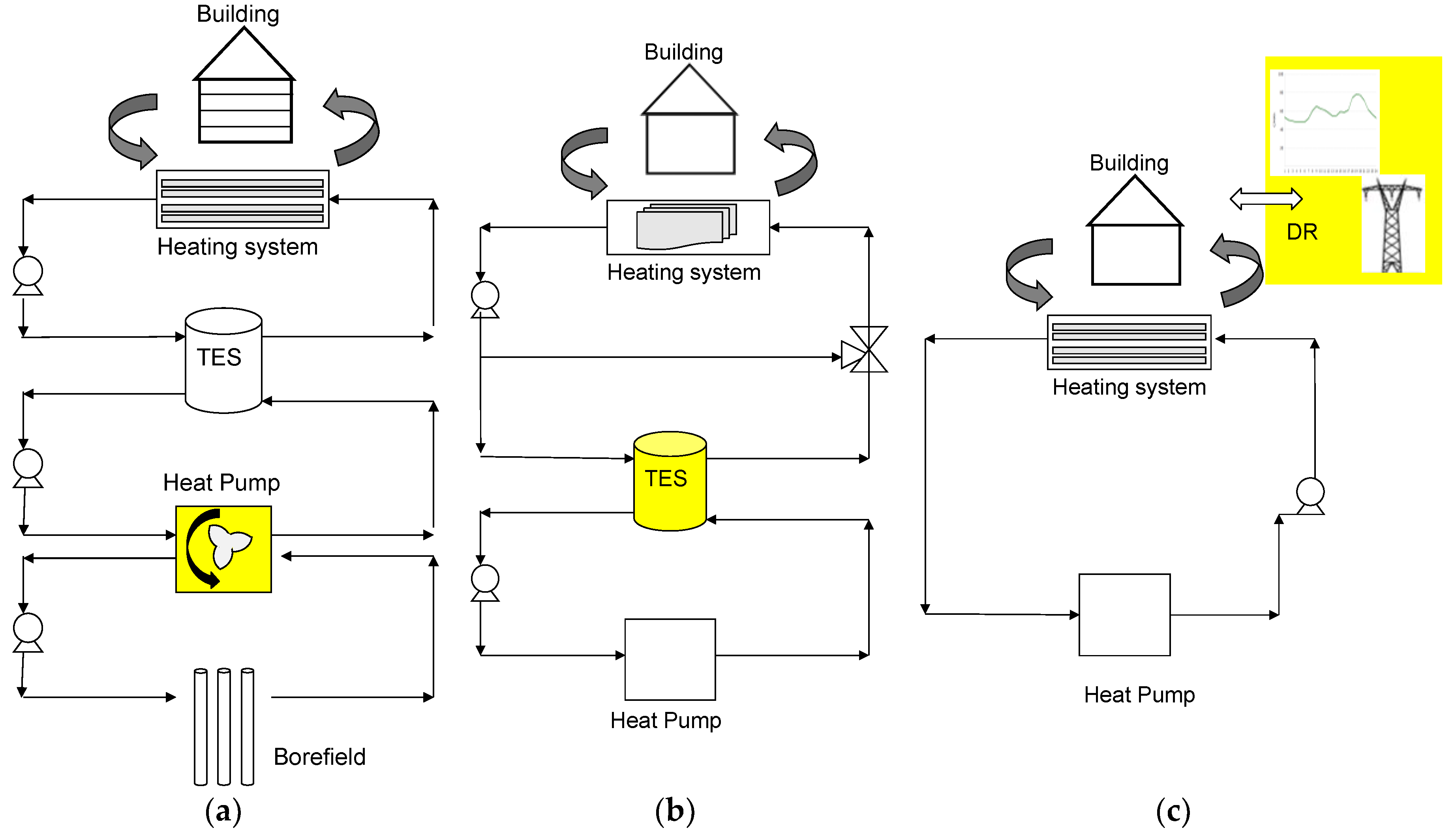

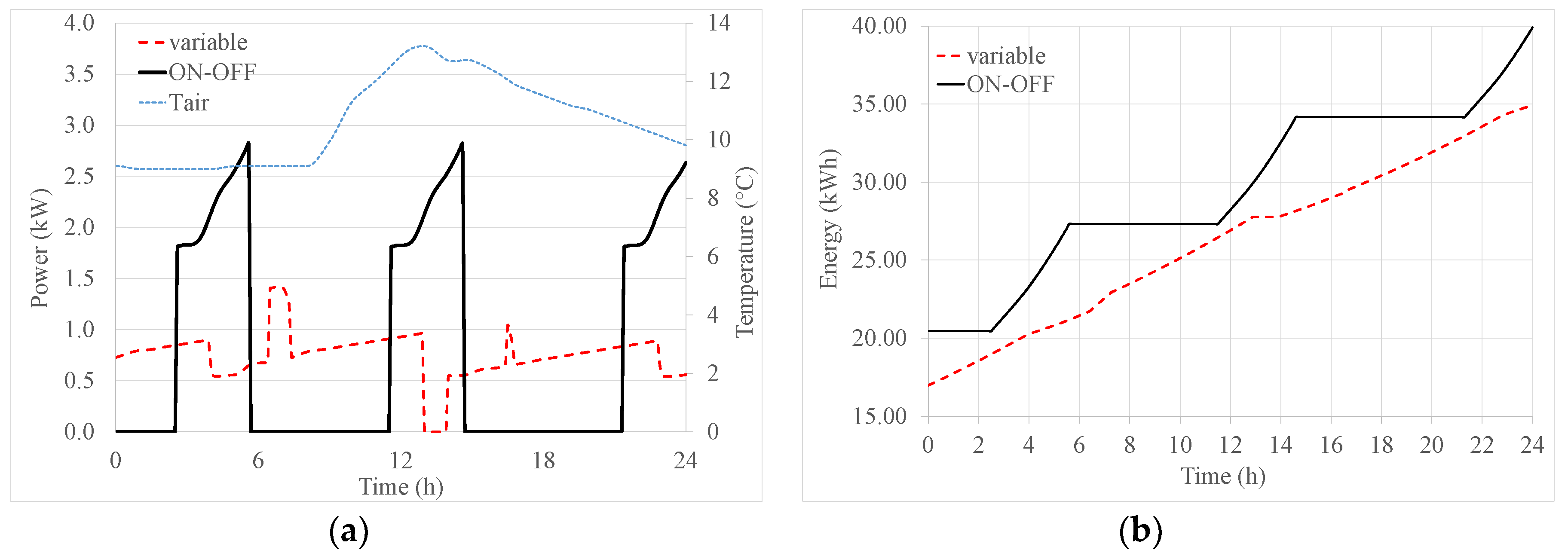
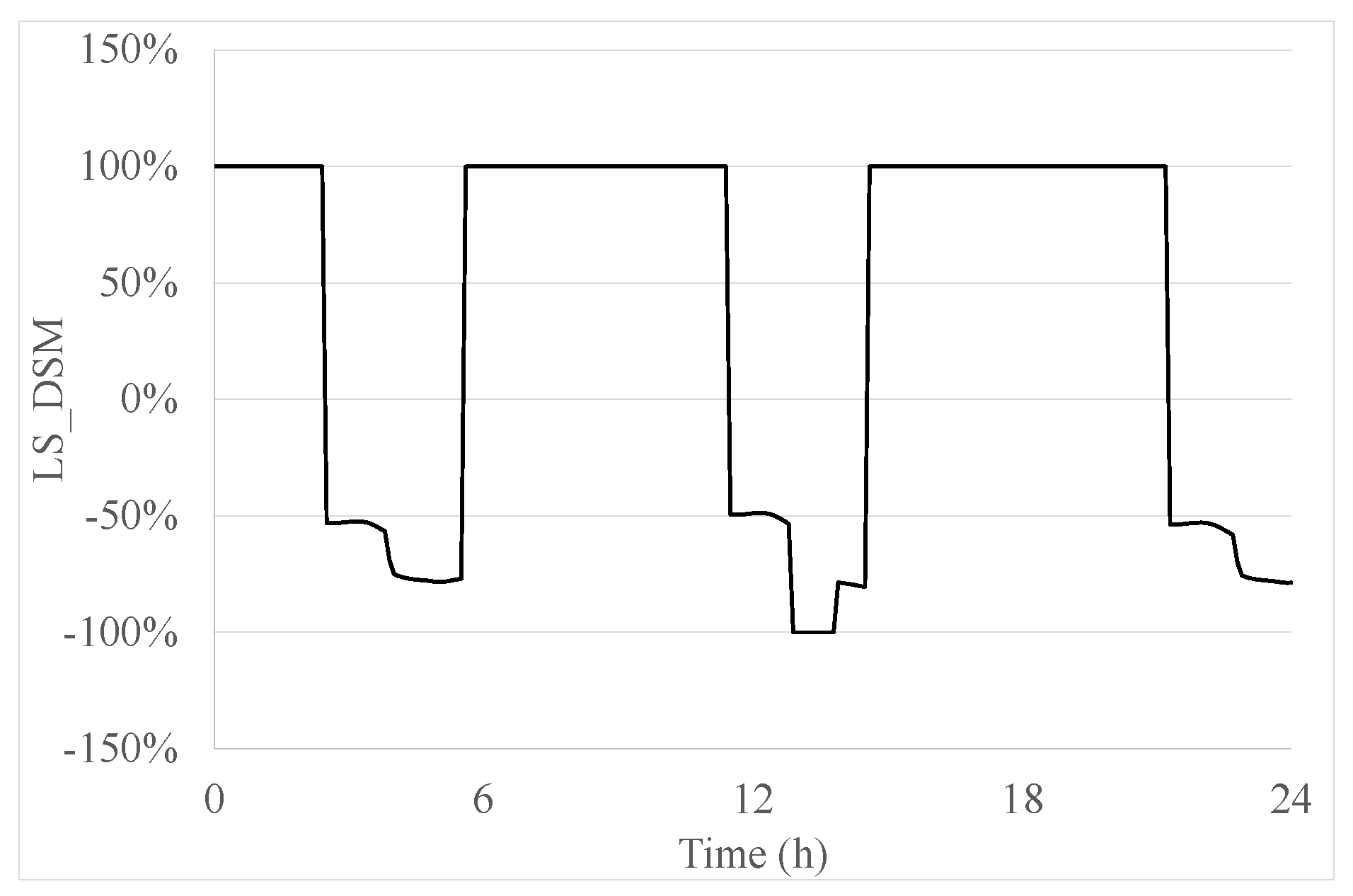
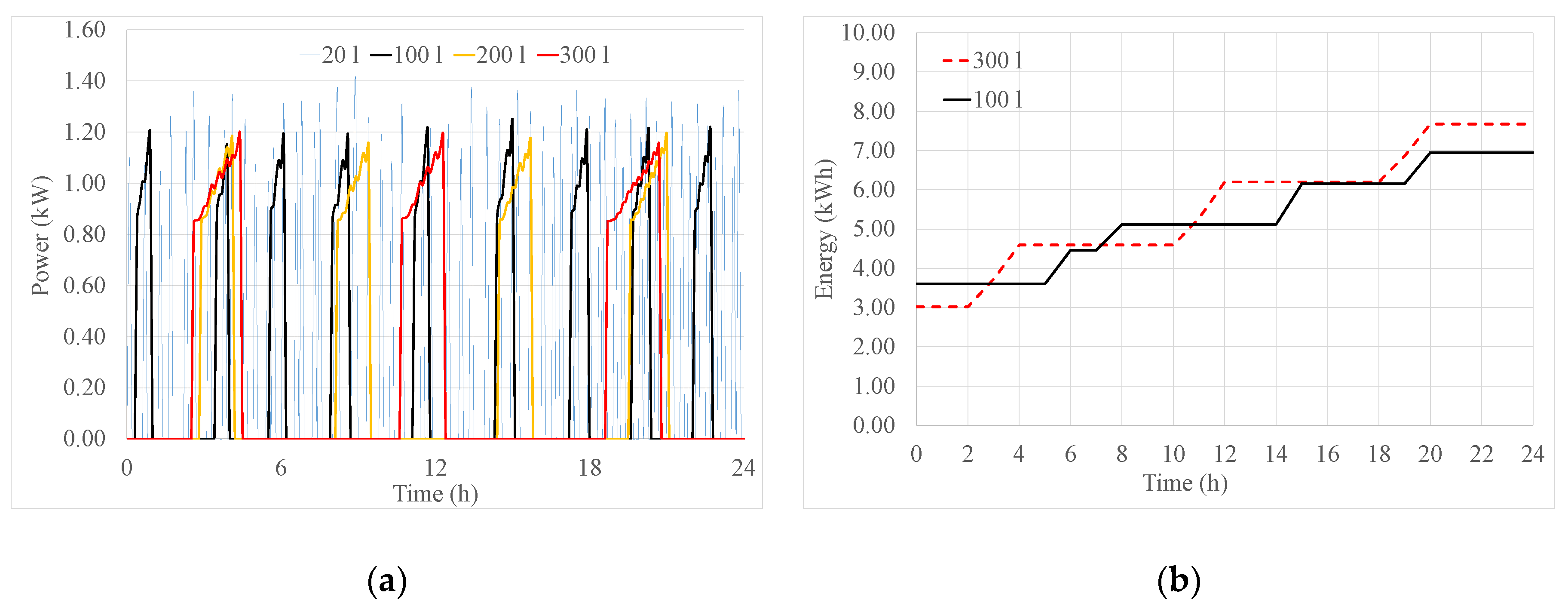

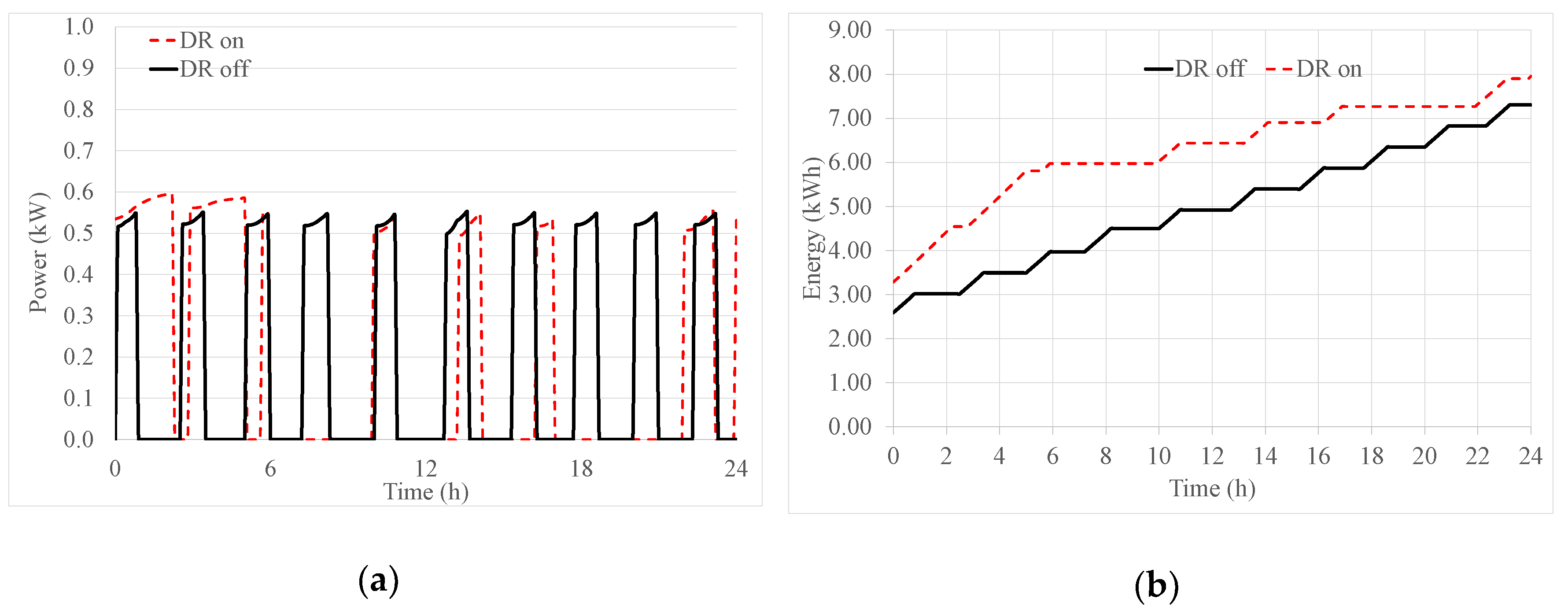


| Category | Technology |
|---|---|
| Energy efficiency | Natural refrigerants Optimal design Not-in-kind technologies Optimal control strategies |
| Storage | Cold Thermal Energy Storage/Thermal Energy Storage Thermally Activated Buildings Phase Change Material |
| Demand Response | Ancillary services (frequency and voltage control, congestion management, spinning and non-spinning reserves) Renewable Energy Sources integration Cost reduction |
| Case | Area m2 | S/V | Windows Area % | U_Wall W/m2K | U_Roof W/m2K | U_Windows W/m2K |
|---|---|---|---|---|---|---|
| A | 1000 | 0.37 | 10 | 0.30 | 0.23 | 1.4 |
| B | 100 | 0.37 | 10 | 0.36 | 0.28 | 2.10 |
| C | 100 | 0.37 | 10 | 0.36 | 0.28 | 2.10 |
| Specification | Case A | Case B | Case C |
|---|---|---|---|
| Heating system | GCHP | ASHP | ASHP |
| Distribution system | floor | radiators | floor |
| Heating system supply temperature | 20–40 °C | 40–50 °C | 20–40 °C |
| HP design capacity | 8 kW | 3 kW | 2 kW |
| COPdesign | 4 | 2.5 | 3 |
| Tank volume | 1000 L | 20 L, 100 L, 200 L, 300 L, 1000 L | -- |
© 2018 by the authors. Licensee MDPI, Basel, Switzerland. This article is an open access article distributed under the terms and conditions of the Creative Commons Attribution (CC BY) license (http://creativecommons.org/licenses/by/4.0/).
Share and Cite
Arteconi, A.; Polonara, F. Assessing the Demand Side Management Potential and the Energy Flexibility of Heat Pumps in Buildings. Energies 2018, 11, 1846. https://doi.org/10.3390/en11071846
Arteconi A, Polonara F. Assessing the Demand Side Management Potential and the Energy Flexibility of Heat Pumps in Buildings. Energies. 2018; 11(7):1846. https://doi.org/10.3390/en11071846
Chicago/Turabian StyleArteconi, Alessia, and Fabio Polonara. 2018. "Assessing the Demand Side Management Potential and the Energy Flexibility of Heat Pumps in Buildings" Energies 11, no. 7: 1846. https://doi.org/10.3390/en11071846





